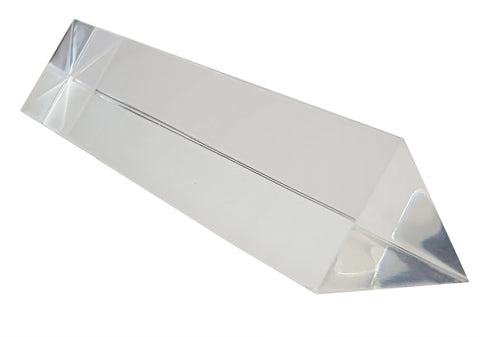GSC International 4-90977A Prism Acrylic Equilateral, 25mm side length (face) x 150mm overall length.
These prisms are made of optically-clear acrylic. They have an equilateral triangle shape, and are boxed individually. Each side of the equilateral-triangle-face is 25mm. This prism is 150mm long.
The equilateral prism serves as a practical and visual tool for teaching fundamental optics concepts, helping students better grasp the behavior of light.
The prism is most famously used to show how white light can be split into its component colors, a phenomenon known as dispersion. When light passes through the prism, it bends (refracts) due to the change in medium, and different wavelengths of light bend by different amounts. This spreads the light out into a spectrum of colors, demonstrating how visible light is composed of various wavelengths.
The equal angles of an equilateral prism ensure that the light paths through it are predictable, which simplifies the analysis of refraction and reflection in demonstrations. This makes it easier to teach concepts like angle of deviation and minimum deviation.
The symmetry of the prism makes it easier to understand and calculate the bending of light at both the entry and exit points. This consistency helps reinforce the idea that the angle of refraction depends on the angle of incidence and the material’s refractive index.
In advanced applications, an equilateral prism is used in spectroscopy to analyze the spectral composition of light sources. This is important for learning about atomic and molecular energy levels.
PRODUCT WARNINGS
 WARNING: This product can expose you to chemicals including ethyl acrylate, which are known to the State of California to cause cancer, birth defects, or other reproductive harm. For more information go to www.P65Warnings.ca.gov.
WARNING: This product can expose you to chemicals including ethyl acrylate, which are known to the State of California to cause cancer, birth defects, or other reproductive harm. For more information go to www.P65Warnings.ca.gov.
Our products are not toys. Use in a laboratory or educational setting only. Not for children 13 and under.

